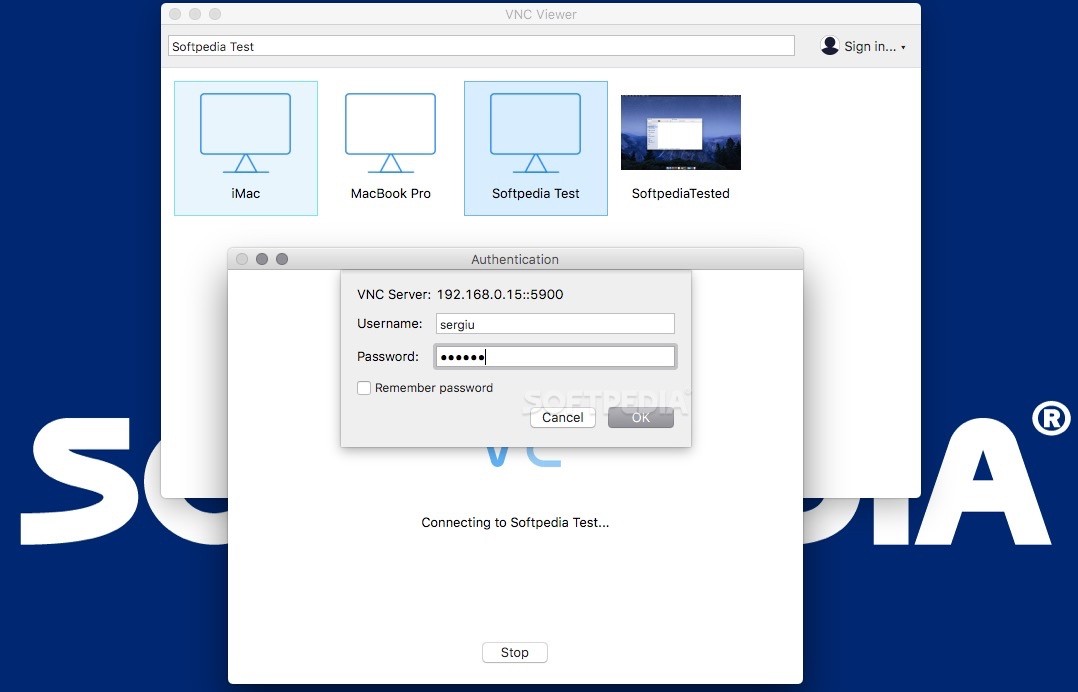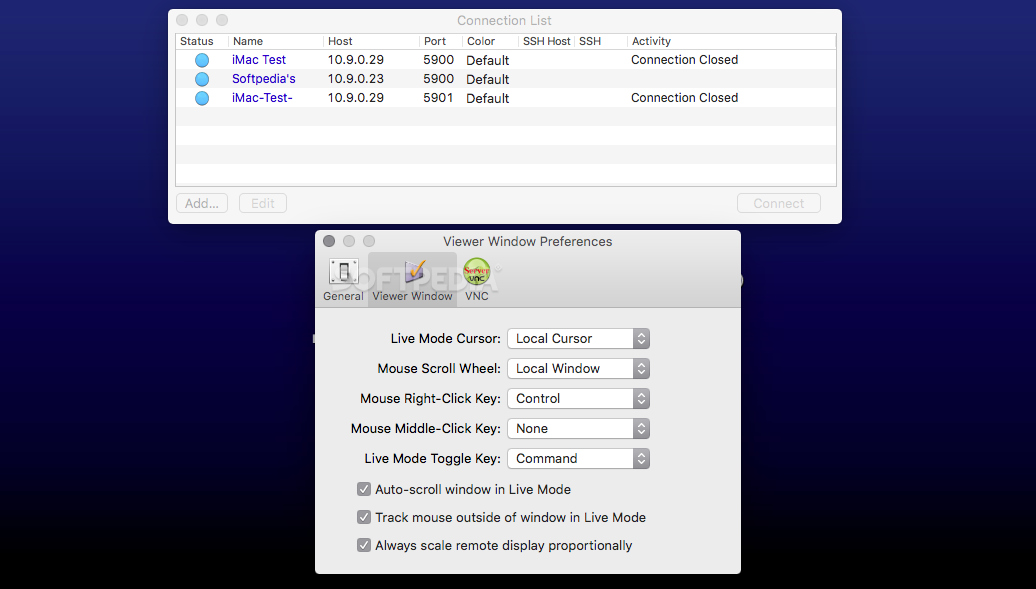Remote control of your Macintosh allows you to access a remote (host) computer across a network or the Internet from a local (client) system. The screen of the shared host computer appears locally, and you use your mouse and keyboard to control the other system from afar. Historically there have been fewer options to accomplish this for Macs than PCs, but the situation has been improving steadily.
- PKG 10.6 To 10.8
- Free Vnc For Mac Os X 10.11
- The Best VNC Screen-Sharing Software - Lifewire
- Download Ultravnc Mac Os X 10.5 For Free (macOS)
- Vnc For Mac Os
- Vnc For Mac
Part 1 of this covers general considerations and Apple-supported methods available for remote system control that will generally work on any version of Mac OS X (Jaguar, Panther, Tiger, and Leopard). Part 2 addresses some commercial solutions that also support multiple OS versions, along with how to force-reboot a remote Mac. Part 3 looks at on new options provided by Mac OS X 10.5 Leopard.
General Considerations
Remote control capabilities vary by method used and include remote desktop control (screen sharing), file transfers, and system management (patches and updates). With any remote desktop method, access to the remote system is slower than when you are sitting in front of that computer. The method used, network bandwidth available, and types of traffic will determine the “sluggishness” factor.
PKG 10.6 To 10.8
Vine Server is a full featured VNC server for Mac OS X providing remote access to the GUI, keyboard and mouse using Vine Viewer or any other VNC client. Vine Server offers a rich and unique feature set among Mac OS X VNC servers including:. Flexible port assignment for multiple VNC servers on a single computer. See full list on wikihow.com. To enable VNC on a Mac, you can either turn on the support for it that’s built into OS X or install a free third-party VNC server. To turn on the VNC service in Leopard or Snow Leopard, start.
- Vnc free edition free download - VNC Viewer, WavePad Masters Edition for Mac, PDF OCR X Community Edition, and many more programs.
- Vnc free edition free download - VNC Viewer, WavePad Masters Edition for Mac, PDF OCR X Community Edition, and many more programs.
Minimizing the amount of data you need to transmit for screen sharing will make the process run more quickly. Closing unnecessary windows on the remote system and using a flat single-color desktop (instead of a complicated picture or pattern) will speed up response. Patience is a must, but remember it’s usually faster than traveling there!
Needs and realities often dictate your options. Some remote control methods work across different versions of the Mac OS (or cross-platform), while others require the same OS version on local and remote machines. Some methods require you to know the IP address of the remote system to connect and may require special firewall configurations, while others will work without any special settings or knowledge – usually!
It’s often helpful to use two remote control methods simultaneously (if possible), especially if you’re running a server or access is otherwise critical. Programs crash, network and Internet conditions vary, and you may find yourself locked out at a critical time. Sometimes method B works when method A doesn’t; then you can fix method A or reboot the machine from afar.

Apple Remote Desktop (ARD)

Apple’s native remote control solution is Apple Remote Desktop (ARD). ARD server software has been built into Mac OS X since 10.3 Panther and was available as an optional install for earlier versions of OS X. ARD provides the full gamut of remote system control: scalable screen sharing, file transfers to and from the remote systems, and remote software updating of individual machines and whole networks at a time. On a LAN, network admins with multiple Macs to manage will find this tool indispensable.
To enable an ARD host (server) in Panther and Tiger, go to System Preferences –> Sharing and turn on Apple Remote Desktop, then click Access Privileges and enable all desired services for one or more users. In Leopard you also enable ARD via System Preferences –> Sharing, but control capabilities have been split into separate Screen Sharing and Remote Management sections; click Options for choosing Remote Management services. ARD access from afar is via your host Mac’s account password.
To control an ARD-shared host computer, you need to use the Apple Remote Desktop administrator software. Apple sells two versions, a 10-client version for $299 or an unlimited client version for $499. The client limit dictates how many remote systems you can manage simultaneously; most home users and small business will be fine with the 10-client version. Bonjour support is available to find systems on your local network, or you can add them by IP address.
Across the Internet you must know the IP address of the remote computer or network gateway to establish a connection; this requires either a static IP address on the remote end or the use of a dynamic DNS locator service (like DynDNS) to find your remote system in times of need. ARD requires forwarding TCP and UDP ports 3283 through firewalls. Traffic can be routed across VPNs if one is available.
ARD is a powerful tool, but power comes at a price. Fortunately for home and small business users there are other options.
Virtual Network Computing (VNC)
VNC is an open source software effort to provide cross-platform remote screen sharing capabilities. Long an option for Windows, VNC support was spotty on Mac OS 9 but is solid on Mac OS X. It has become my primary method of controlling remote Macs and PCs from other Macs (and PCs) when static IP addresses are available.
The remote Mac needs to run a VNC server; starting with Mac OS X 10.4 Tiger the built-in ARD software has included the option to use VNC for screen sharing. Go back to System Preferences –> Sharing –> Apple Remote Desktop (Tiger) or Screen Sharing (Leopard) and click the Access Privileges or Options button (as applicable). Enable Share Screen with VNC clients and use a strong password.
On pre-Tiger Macs or as an alternate option for all Macs, the free Vine VNC Server (for OS X and OS 9) and it’s older precursor, OSXvnc, offer excellent VNC server packages with more options than Apple’s built-in server. In my experience the Vine and OSXvnc packages are more stable and resilient than Apple’s built-in server – I’ve had onboard VNC stop working many times and require a reboot to fix, while the standalone server rarely fails. I use Vine VNC Server on many of the business systems I support.
A VNC client viewer application is required to view your remote Mac on your local system. Apple did not provide a VNC viewer in Mac OS X until 10.5 Leopard (see Part 3 of this series), but the open source market came earlier to the rescue. Chicken of the VNC is a good free VNC viewer with a silly name, and it runs on Mac OS X 10.3 Panther through 10.5 Leopard.
For a step up, $30 will get you the Vine VNC Viewer; this software is faster and more stable than Chicken of the VNC, and it offers screen size scaling (invaluable when controlling a big screen from a small laptop) and clipboard sharing. Mac OS X Tiger or Leopard is required.
Both Vine and Chicken of the VNC will find local network systems using Bonjour. Across the Internet you will need to know the IP address of the remote computer or use a dynamic DNS locator service. VNC uses TCP port 5900 for control and, as with ARD, requires port forwarding through firewalls and routers. VNC works fine across VPNs.

VNC provides screen sharing capabilities without file transfers. To work around this limitation you can use a network and/or Internet-accessible resource that both systems can reach: an FTP server, a shared Mac disk using AFP (AppleShare), a shared Windows volume using SMB, or a webserver with upload/download capability. Post the software or document from one system and grab it from the other via your shared disk or server.
Continued in Software to Remotely Control and Reboot Your Mac.
Methods of Mac Remote Control
- Part 1: Remotely Control Your OS 9 or OS X Mac
This article was originally published on Adam’s Oakbog website. It has been adapted and reprinted here with his permission.
Free Vnc For Mac Os X 10.11

Keywords:#appleremotedesktop #vnc
Short link: http://goo.gl/DZUs4C
searchword: macremotecontrol
A VNC server has been included with every edition of Mac OS X, including Mac OS X 10.7 – aka Lion. Let's walk through how to start the server on Lion.
The Best VNC Screen-Sharing Software - Lifewire
This article refers to Mac OS X 10.7, aka Lion. Other versions are available on our VNC on Mac OS X page.
VNC is an acronym of Virtual Network Computing. You can use your Mac's free VNC support to remotely connect and control your Mac over a network. You can even control your Mac remotely over the Internet.
In Mac OS X 10.5, aka Tiger, Apple introduced Screen Sharing to the Finder. While Screen Sharing appears to be built on VNC, it uses a more sophisticated authentication process that stops most generic VNC clients connecting.
To start a general VNC server on your Mac you need to click a few check boxes.
Starting the Mac OS X 10.7 VNC Server
- Launch the System Preferences.
- Select the Sharing preferences.
- Enable Screen Sharing within the Service list.
- Click Computer Settings… to show the VNC password setting.
- Enable VNC viewers may control screen with password:.
- Enter a strong password.
- Click OK to save your settings.
Download Ultravnc Mac Os X 10.5 For Free (macOS)
Your Mac is now running a VNC server and can be connected to from other computers using the standard VNC port (TCP/IP port 5900). Those connecting will need to use the password you entered in step 6.
Vnc For Mac Os

Vnc For Mac
The VNC server will start every time you power on your Mac. If you want to stop the VNC server, navigate to the Sharing preferences and disable Screen Sharing.
